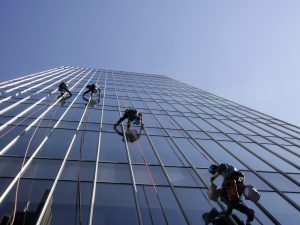The Occupational Safety and Health Administration, OSHA, has issued new construction standards that regulate the construction and use of scaffolds. These standards, identified as 29 CFR Part 1926, Subpart L, became effective on November 29, 1996 and apply to both the erectors of scaffolds and the users of scaffolds. The new standards are written as “performance” standards, a refreshing improvement over the original standards, which were written as “specification” standards. Performance standards allow for greater flexibility in compliance. For example, the old standards required a guardrail system on scaffold platforms over a certain height. Instead of specifying guardrails, the new standard only requires that fall protection be provided for the employee, allowing the employer to choose between guardrail systems and personal fall protection equipment. Additionally, the guardrail system can be constructed of any material provided it meets certain strength requirements.
Subpart L has also been reorganized, following the format that has been used on other subparts of the construction standards, most notably Subpart M, fall protection, and Subpart X, stairways and ladders.
Subpart L contains five paragraphs and five non-mandatory appendices:
1. Paragraph 1926.450: Scope, application, and definitions
2. Paragraph 1926.451: General requirements
3. Paragraph 1926.452: Additional requirements applicable to specific types of scaffolds
4. Paragraph 1926.453: Aerial Lifts
5. Paragraph 1926.454: Training Requirements
6. Non-mandatory Appendices A through E
A) Scaffold Specifications
B) Criteria for determining feasibility of providing safe access and fall protection for scaffold erectors and dismantlers. Note: This appendix has not been written at this time.
C) List of national consensus standards
D) Training topics for scaffold erectors
E) Drawings and illustrations
SCOPE, APPLICATION, AND DEFINITIONS
The scope of Subpart L includes all scaffolds and aerial lifts. Crane or derrick suspended personnel platforms are excluded since they are covered in Paragraph 1926.550(g) of the construction standards. The old definitions, which were at best inaccurate and incomplete, have been greatly improved and expanded. These new definitions make understanding the standards easier in despite the fact that there still are insufficient illustrations for the various types of scaffolds.
GENERAL REQUIREMENTS
In a radical departure of the old standards, the general requirements address scaffold criteria that are applicable to all scaffolds. There are requirements for scaffold capacity, platform construction, supported scaffolds (formerly referred to as stationary scaffolds), suspended scaffolds (basically any scaffold supported by suspension ropes or cables), access, use, fall protection, and falling object protection. Some highlights of the General Requirements include:
• Scaffolds shall be designed by a qualified person and constructed and loaded in accordance with that design.
• All scaffolds must have at least a 4 to 1 safety factor.
• Suspension ropes must have at least a 6 to 1 safety factor.
• Platforms are to be fully decked between the front uprights and guardrail supports.
• Each platform shall be at least 18 inches wide except ladder jack, top plate, roof bracket, and pump jack platforms which shall be a minimum of 12 inches wide.
• The front edge of platforms shall be no more than 14 inches from the face of the work except for lathing and plastering, where the distance is 18 inches.
• Scaffolds are to be tied to the structure more frequently than the old standards specified.
• Fork-lifts can be used to support platforms if the entire platform is attached to the fork and the fork-lift is not moved horizontally while the platform is occupied.
• Criteria for suspended scaffolds has been greatly expanded to specifically address items such as counterweights, connections, and tiebacks.
• Scaffold access shall be provided when the platform is more than 2 feet above or below a point of access.
• Proper access includes ladders, stairs, ramps, and walkways.
• Crossbraces cannot be used as access.
• Scaffold frames might be proper access if they are specifically designed and constructed for use as ladder rungs. (Very specific criteria is provided to make that determination.)
• Scaffold erectors are exempt from certain access provisions until September 2, 1997.
• Scaffolds shall be erected, moved, dismantled, or altered only under the supervision and direction of a competent person qualified in scaffold erection, moving, dismantling, or alteration.
• Work on scaffolds is prohibited in high winds.
• Fall protection shall be provided for employees working on platforms more than 10 feet above a lower level.
• Guardrail system suggestions can be found in the appendices.
• Each employee on a boatswain’s chair, catenary scaffold, float scaffold, needle beam scaffold, or ladder jack scaffold, shall be protected by a personal fall arrest system.
• Effective September 2, 1997, the employer shall have a competent person determine the feasibility and safety of providing fall protection for employees erecting or dismantling supported scaffolds.
• Toeboards are addressed as “falling object protection,” clarifying installation requirements. As an alternate to toeboards, canopies and other methods are allowed.
ADDITIONAL REQUIREMENTS FOR SPECIFIC SCAFFOLDS
Additional requirements for specific scaffolds have been included in the new Subpart L. While these additional requirements are similar to the old standards, there have been notable improvements and one conspicuous omission. For example, mobile scaffold standards are basically unchanged except for the removal of conflicting information concerning fall protection and access. The employer is still allowed to permit employees to ride scaffolds under some very controlled circumstances, although many industry personnel consider this a very dangerous practice.
The regulations covering tube and coupler scaffolds remain essentially unchanged except for transverse bracing requirements. Additionally, as was described earlier, the requirements for platforms and fall protection have been deleted since these requirements are addressed in the general regulations for all scaffolds.
The conspicuous omission relates to systems scaffolds, such as Brand Scaffold Brandlock, or Patent Construction Services QES Scaffold. Although there are specific requirements for tube and coupler scaffolds and frame scaffolds, there are no specific requirements for systems scaffold. Consequently, the erector is to comply with the general requirements which specify minimum expectations for scaffold strength, stability, fall protection, access and other requirements.
AERIAL LIFTS
Aerial lifts are now addressed in the new standard, having been moved from Subpart N of the Construction Standards. Included in the standards are general requirements covering all aerial lifts, specific requirements for ladder trucks, tower trucks, extensible and articulating boom platforms, electrical test requirements, and bursting safety factor requirements.
TRAINING REQUIREMENTS
Industry experts agree that the most significant paragraph of the new standards is Paragraph 1926.454, training requirements. While the OSHA Standards always required the employer to provide training for the employee, this new paragraph clearly defines what is expected of the employer in training employees who use, erect, dismantle, inspect, and repair scaffolds. To further emphasize the importance of training, OSHA makes it clear that the training must be conducted by a “person qualified in the subject matter.” No longer is it permissible for the foreman, for example, to conduct a tailgate meeting, using a preprinted information sheet that he knows nothing about! While it is still unclear as to the method of enforcement, or evaluation of the trainer’s qualifications, it is clear that OSHA expects the training to be legitimate and meaningful.
SUMMARY
Only a few of the changes have been discussed in this article. Overall, the new standard is an improvement in the standards in regulating the use of scaffolds, and its performance format should make it easier for employers to conform with the standards. It should be remembered, however, that the new standards, as with all standards, are minimum requirements, and not instructions for the safe use of scaffolds. It is imperative that the employer seek out additional scaffold information from manufacturers, associations, and qualified experts before allowing their employees to erect or use scaffolds.











